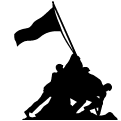The Korean War Monument
On June 25, 1950, Communist North Korean armed forces crossed the 38th parallel and invaded South Korea in a full scale war of aggression, determined to place the entire Korean peninsula under their control.” Three years later a cost of more than 41,000 dead, missing in action or accounted for U.S. troops, an armistice was signed, establishing the boundary line between North and South Korea at the 38th Parallel, the point of the initial invasion.
This was the first time in history that the United States of America joined together with the other members of the Unites Nations Security Council to repel communist forces anywhere. By many accounts, this “forgotten war” was a war with unprecedented costs and importance in which we turned the tide against Communism.
To commemorate this tremendous sacrifice, and as a lasting expression of gratitude and pride, the Korean War Monument was dedicated on the front lawn of the War Memorial on July 25, 1993, the 40th Anniversary of the armistice which ended the conflict. At the dedication ceremony, the prevailing message among both the speakers and the audience was the Korean War veterans had not been recognized by the Danbury community for their service and sacrifices with an enduring symbol. To that end, the monument is the culmination of four and a half years of planning and construction coordinated by the Greater Danbury Area Korean War Veterans Committee at a final cost of $80,000.
Designed by local artist Mark Roy Swenson and sculpted by George Koras, the stone is made of polished India black granite. It was quarried in five individual sections at a total weight of 20,000 pounds. As you face the monument, the left wing contains the names of Danbury area military personnel killed or missing in action during the war.
The right wing contains a brief review and statistical sketch of the war. It is also adorned with replicas of the United Nations and Korean Service Medals as well as the emblems of the five United States military organizations that participated in the war.
The center pillar is 8 feet tall and is capped with a 54 inch bronze eagle resting on a half globe. An eagle was chosen because so many different types of people – soldiers, sailors, nurses, doctors – served in Korea that no one human figure could adequately honor all the various service personnel. Below the eagle on the center pillar, there is a three dimensional hand-etched map identifying towns and battle sites. All engraving on the monument was done through a technique called “skin frosting”, which produced a white image on the black granite. A bronze dedication plaque is located directly in front of the center pillar.
